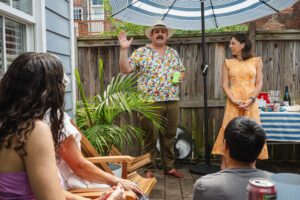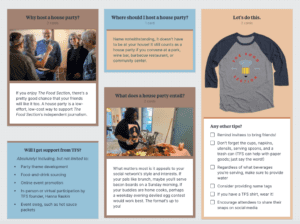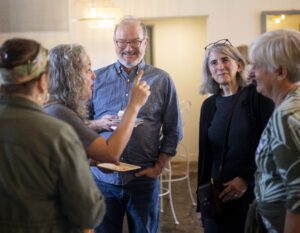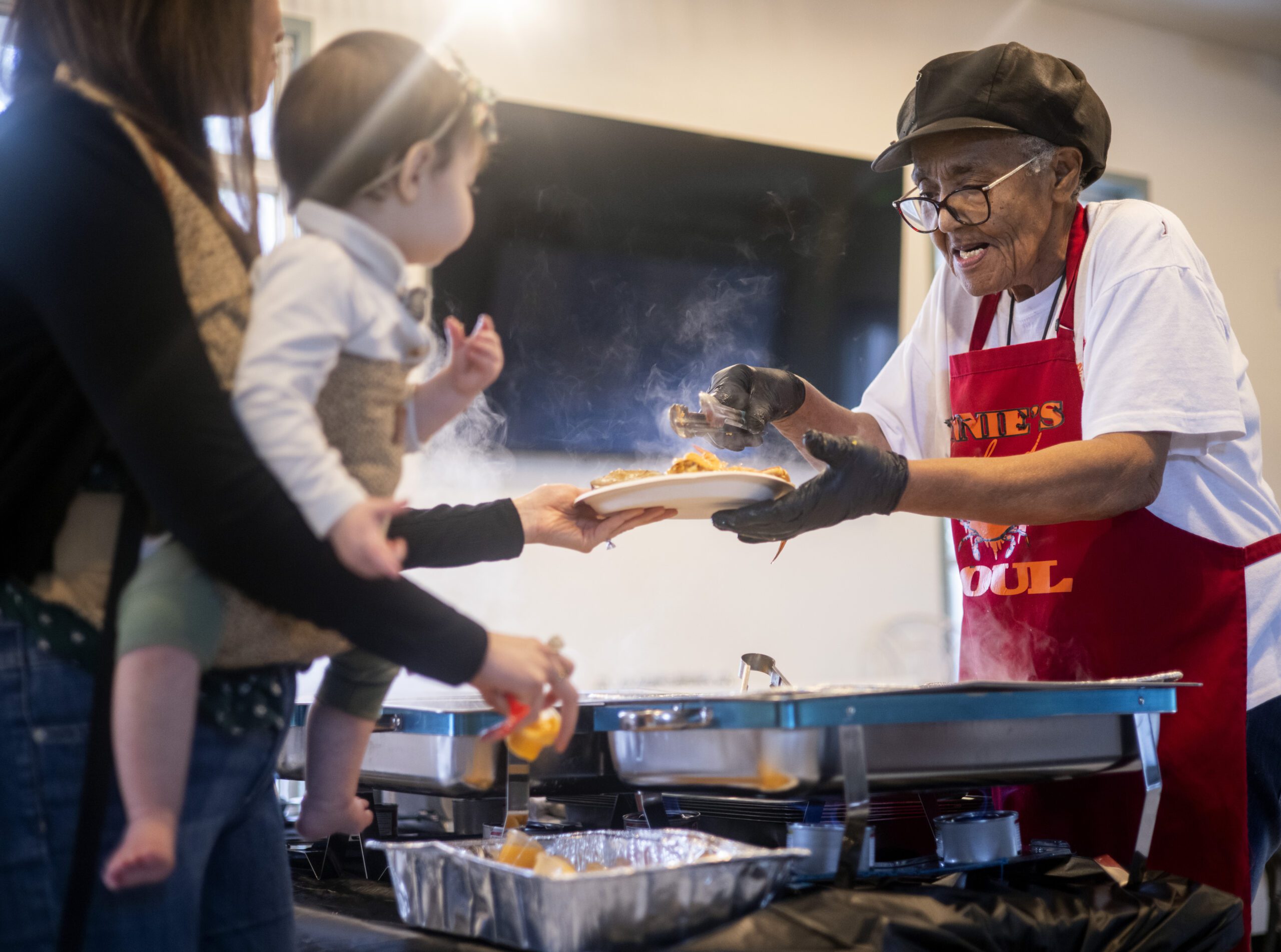By Catherine Komp, Engagement Director
The Food Section’s Publisher and Editor Hanna Raskin is part of CUNY’s inaugural Emerging News Leadership Program and at their first gathering earlier this year, the topic of election night pizza came up.
“And it brought on such a reverie among every reporter in the virtual room that in the following session, the instructor had to apologize for those reporters who weren’t based in the US to say, ‘Look, I’m sorry, you may not have this tradition, but it means so much to us and we’ll try to be more inclusive going forward,’” recalled Raskin.
But while the cohort moved on, Raskin couldn’t get it out of her head.
“It really is such a terrific newsroom tradition and it deserves to be celebrated,” said Raskin.
Some election night reporters get it hot, others may devour it cold after returning from the field, and a few still at their desks after midnight may reach for that slightly stale, but definitely still edible remnant of crust to help get them through the final hours.
Anyway you slice it, the ritual is expected in most U.S. newsrooms. But, could it be better?
Raskin thinks so. She dreamt up the “Campaign for Better Election Night Pizza” to raise awareness about the importance of local news, support local businesses and provide newsrooms with some of the best pies in NC.
The campaign will unfold in two parts. On Wednesday, October 16th — the day before early voting starts — The Food Section is hosting a blind tasting of pies from 10 Raleigh-area restaurants. You can register for the event as an “Undecided voter,” where $20 gets you three slices, two drinks and one vote; or as a “Proud Partisan” where $150 means unlimited pizza and drinks and 10 votes; or if you can’t make it, vote “Absentee” via email in exchange for any donation.
The Food Section will then deliver the winning pizza to local news organizations within an hour of Raleigh on election night.
It’s fun, creative and community-centered: three ingredients Raskin always reaches for when planning events. This week, we chat with the James Beard award-winner about how she approaches events as a way to deepen relationships with readers and reach new ones. She also shares some event planning resources she built that you can adopt or customize, and some insights about what her audience has taught her about the importance of creating spaces to gather.
(And if you’re just learning about The Food Section, check out this terrific Q&A The Newsletter Collective’s Dan Oshinsky did with Hanna last year to get a good overview about their journalism and business strategy.)
Before we jump in, Hanna is still looking for a few volunteers to help out. Send her a note at raskin@thefoodsection.com if you’d like to help pick up pizzas for the blind tasting event at the The Longleaf Hotel in Raleigh.
NC Local: When you first launched were events a core part of your strategy? At that point, it was during the pandemic.
Hanna Raskin: I officially launched September 2021, so we were at that stage of the pandemic. I had always been interested in events. I had spent nearly 10 years as the food editor of the Post and Courier in Charleston prior to winning a grant from Substack to launch my own publication. And I really enjoyed events and thought they had a lot of potential and perhaps thought they had more potential than our marketing department did so I wasn’t able to make good on all the ideas I had. But the ones that I did do while at the paper were tremendously successful in terms of reader engagement and community interest.
So I don’t know that on day one that I launched The Food Section, I had an event strategy necessarily. In part, because in all honesty, I didn’t really understand what I was taking on. I had planned to just continue functioning as a reporter not really realizing how much of my job was going to be being a business owner and publisher. The events were in the back of my mind, but I didn’t have the event strategy at the start.
But in terms of covering food, it really pretty quickly came to the fore that this is going to be a way to get my readers not just to cultivate a sense of community among them, but food is something that’s best experienced in person. So it became evident that events were going to be part of my business plan.
What were some of the first ones that you did? Did you do virtual tastings?
That’s exactly what we did. Because people were coming out of the pandemic, everyone kind of at their own rates. Additionally, I cover the entire Southeast essentially so getting everyone together in one place wasn’t really in the cards. (Although I should pause and say I always do a subscriber event in March in Charleston because it coincides with the Charleston Wine and Food Festival. Oftentimes there are a lot of folks in town, so that’s been an event almost from the beginning.)
So one of the first events I did was a virtual chocolate tasting, which was really fun. I corralled some chocolate makers across the South and sent out the chocolates to participants in advance. These were all bars and even within just the realm of chocolate, there was this terrific diversity. Chocolate makers who are more interested in the sourcing of their cacao. Chocolate makers who are more interested in crazy flavor combinations. Chocolate makers who are interested in the history of chocolate in the region. So I had maybe a half dozen of these folks and sent out boxes of bars to whatever subscribers had registered. And it was really fun, we all got together on Zoom to meet the chocolate makers and they led folks through the tasting of their bars. Yeah, it was terrific.
You’re still gathering people on Zoom and holding monthly chats. Who’s coming to these and what are you talking about?
That was started because I had some reader or subscriber focus groups and one of the takeaways was these people just like getting together to talk. So many people signed up for the focus groups in part because they care about The Food Section and it’s future, but in part because they’re interested in one another. So we started that this year, making that a monthly function. It’s just a perk of your subscription and you can come or go as you please.
So far a lot of it has been featuring our own contributors. Michael Stern, my restaurant reviewer, did a Q&A for our first Zoom. The second time around, I had just guest edited Gravy, which is quarterly from the Southern Foodways Alliance, and I brought all of the contributors to talk about their pieces. And then most recently we had a subscriber talent show.
Wow, a talent show. You’re going to have to tell us more about that.
So again, this came from the idea that these folks just really have a lot to say and want to talk to one another. Also, The Food Section always takes off from publishing in August. So it felt like a very summertime thing to do, to have sort of a summer camp style [virtual] talent show before break. And it was great. People signed up to sing and play the fiddle and tell jokes and it was a fun time.
Last Spring, you put out a call to see if people might be interested in hosting house parties. Tell us about your strategy here and creating a space for people to come together in-person.
 What had happened was earlier in the year, I’d been fortunate enough to have something of a benefactor fund a PR firm for me with the idea of bringing in more people and getting the word out about the publication. And it really was a flop. It really did not accomplish what I had hoped, but something that emerged from that is realizing what I don’t need is glitzy, glossy PR, and I certainly don’t need to be spending subscribers’ money on things other than journalism. What I need is just good old fashioned, word of mouth advertising and promotion.
What had happened was earlier in the year, I’d been fortunate enough to have something of a benefactor fund a PR firm for me with the idea of bringing in more people and getting the word out about the publication. And it really was a flop. It really did not accomplish what I had hoped, but something that emerged from that is realizing what I don’t need is glitzy, glossy PR, and I certainly don’t need to be spending subscribers’ money on things other than journalism. What I need is just good old fashioned, word of mouth advertising and promotion.
So that’s exactly how I explained it to my readers and asked if anybody would be willing to put on a house party, as you might for a political candidate or for a folk singer or anyone else who is situated much like an independent news publisher, who doesn’t have a lot of money, but they have a purpose. And people were terrific in their responses and incredibly enthusiastic, in part because I think it is a food publication so these are folks who enjoy getting together, eating and drinking and having fun. So when they were asked, do you want to throw a party, they certainly did. I had more volunteers to do this than I was able to accommodate on this first round. We did two parties in New York City, one in Fayetteville, NC. And I’m just today returning from one in Richmond, VA.
How do these work? How much support do you give the party throwers and how do you make sure that things stay focused on promoting The Food Section?
 Totally great question. So it was really fun to put together a guidebook for prospective hosts. I got to mess around with some new tech and put something together. So it’s plug and play. People have the registration forms ready to print and it gives them a good sense of what to have on hand, like water and especially the napkins. I always provide The Food Section branded napkins.
Totally great question. So it was really fun to put together a guidebook for prospective hosts. I got to mess around with some new tech and put something together. So it’s plug and play. People have the registration forms ready to print and it gives them a good sense of what to have on hand, like water and especially the napkins. I always provide The Food Section branded napkins.
So the guide explains everything. And it’s been a learning process as all things are. I figured out after the first event that people had a great time, but a lot of them still didn’t learn what The Food Section was or why they were there. So I modified the model after the first time we tried this, and now I do a Q&A with the host right in the middle of the party, which is great for messaging.
I have Food Section branded hot sauce packets that people can take with them, so that’s great to help spread the message. I also print a selection of greatest hits twice a year, so I bring that print edition so people can take a look at some of the stories that we publish and the kind of journalism they’re supporting.
This might be a little bit more expensive, but you could also do Food Section branded potholders.
(Laughs) Now I’m picturing it, trying to keep my budget in line, and asking people to sew those potholders. But you know, it’s funny you say that because one of the misconceptions about what I do that I’m constantly having to correct is that I don’t run recipes and I don’t write much about home cooking, you know? And so it’s really interesting, trying to think up what’s an affordable takeaway that’s actually in line with The Food Section’s brand. And something that adds a little spice to your dish I decided was probably pretty spot on.
How are you measuring success for the house parties?
Another big part of this has been developing not just the framework for the host, but for myself. To have all the evaluation forms afterward and to figure out the KPIs and make sure this is working, has been part of the process.
Measuring success is a little tricky. Obviously the clearest metric is I always have a discounted subscription price available to attendees. So any use of that is obviously a win. But some of it’s harder to track. You don’t know where those hot sauce packets are going to end up. So, I measure social media mentions, I do evaluations to see how people are feeling about the publication and what they plan to tell other people about it. But yeah, and this is true for all of us and all we do, people have to hear about something so many times before they take action. So some of the subscriptions that these events yield, they may not show up for another couple months.
I imagine there’s food at these events.
Yes, definitely. One of the things that we’re trying to demonstrate through these events is part of The Food Section’s mission is to make our readers’ meals more meaningful and to connect them with culinary experiences they would never have otherwise. I toted South Carolina pickled watermelon rinds up to New York City from an heirloom watermelon that’s just been growing in Blackville, SC, and there’s nowhere else they’re gonna get that. I brought fresh beans up to New York City, and chef was so excited. So that kind of thing is really fun.
How much do you want these audience engagement events to contribute to your revenue pie and are they?
I would love for it to be more. I’m still figuring it out, obviously, but at this point, I’m typically breaking even on events. I’d love for them to be profitable so that’s still something I’m figuring out in terms of the substance of the event, the pricing, just trying things out and seeing what works.
What have you learned from your audience about events, both virtual and in person?
I gotta say they love it. They really love it. They really are having a good time coming together. One of the things I’ve learned is that their enthusiasm for information is really high. In the case of these house parties, I had really put the emphasis on party, thinking people would eat and drink and mingle and all of that. But I’ve added these Q&As about The Food Section because people really want to know more as well as just consume.
What are some practical lessons about pulling these events off? You’re a very small journalism organization and you’ve added some bureaus, so there’s some help there. But what have you learned about how to do these events with limited resources?
 It’s a great question. I think it’s really important from the start that it sounds like fun. If you can build enthusiasm that really helps a lot. And there’s nothing wrong with fun. I’m really excited about this pizza event in part because drawing people into election season is what news outlets do. And if we can do it and make it fun at the same time, I think that’s great. So that’s important.
It’s a great question. I think it’s really important from the start that it sounds like fun. If you can build enthusiasm that really helps a lot. And there’s nothing wrong with fun. I’m really excited about this pizza event in part because drawing people into election season is what news outlets do. And if we can do it and make it fun at the same time, I think that’s great. So that’s important.
What else have I learned? People are accepting of paper plates and napkins. You don’t have to rent. I’m really trying to keep costs down wherever I can.
Part of the idea of this house party is to have a format that’s replicable. If you can figure something out, then you don’t have to start from scratch if you already have a template and can repeat it. That’s useful. You want to think about the planning process; like with everything, planning is the most important thing. Not only do you want something fun that’s gonna draw enthusiasm and ticket sales, but I am learning more about attracting sponsors. So for example, our house party in Charleston in September, the theme for that is eggs and rice, which is a really traditional lowcountry dish that tourists tend to overlook in favor of things like shrimp and grits, which are much, much newer introductions to lowcountry cuisine. And as soon as I knew we were serving eggs and rice, I got in touch with an egg producer and I got in touch with the rice producer and that made a huge difference. I mean that party is completely covered.
Resources from Hanna:
➡️ House party guidebook for prospective hosts
➡️ Template for tracking expenses and ROI
➡️ Evaluation form for attendees
Related reading:
📚Better News: 6 live journalism event ideas you can replicate in your community (including examples from The Assembly, BPR and Enlace Latino NC)
🧰 API’s live journalism events workbook: includes templates for event proposals, goals, design, partners/sponsors, promotions and feedback.



